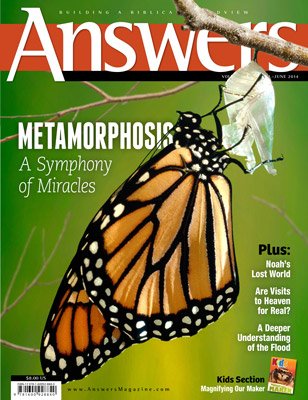Readers Respond
In your latest issue, I am so tickled by the “Let There Be Truth” cartoon . . . so awesome.
Patricia B., Yorktown, Canada
Alien Life
The fact that none of the exoplanets that have been discovered are capable of supporting the kind of life we have on earth doesn’t mean they are uninhabited. God is able to create suitable life for any kind of environment.
Your article contained this statement, “the one place He formed to be inhabited
(Isaiah 45:8).” The verse says God created the earth to be inhabited but it doesn’t say it is the only such place.
Clyde H., Bonner Springs, Kansas
The feature “There’s No Place Like Home” inspired me. I do think it would be unwise to state categorically that God did not create life on any other planets in the universe, since the Bible doesn’t tell us one way or the other.
I expect that in heaven we will learn things about the scope of God’s creative power that we can’t even imagine now, including, perhaps, a knowledge of life forms He created in distant parts of the universe.
Rachel C., East Lansing, Michigan
Author’s Response: I was careful not to say categorically that God didn’t create life on other planets, but that we can be sure that no extraterrestrial creatures are made in the image of God, as we are. However, given the absolutely unique characteristics of Earth among all the planets so far discovered, the likelihood of extraterrestrial life still seems rather low.
Mormon Rest
I thoroughly enjoyed Roger Patterson’s article on reaching Mormons. My geology professor and his wife (also one of my professors) are Mormons. Since my professor encourages us to interact in class, I have had many opportunities to share what I believe. I’ve been looking for ways to witness to them more. Your article was a tremendous help. Thank you!
Sara B., Lubbock, Texas
Abel the Prophet
Could another reason for Abel’s “prophet” status have to do with his accurate interpretation of God’s preferred form of sacrifice? Or, perhaps, it was through Abel that God spoke to Cain. Abel’s choice of animal sacrifice follows the example God gave when he covered Adam and Eve with animal skins. That required the shedding of blood, the death of another to cover the sinner—just like God’s free gift of salvation through the shed blood of Jesus Christ.
Cathy B., Elkton, Oregon
Abel was a tender of flocks. Now they weren’t eating lamb, so why did he do that? I think he did it to show his faith that sacrifice was looking forward to the coming Messiah.
Jonathan V., United Kingdom
Author’s Response:The text provides no indication of “God’s preferred form of sacrifice” or that Abel correctly interpreted what that was while Cain did not. The Hebrew conveys the sense that Abel gave the very best of what he had, while Cain just gave God “something.” Thus, the issue is the quality not the substance of the sacrifices. (We know from Hebrews 11:4 that the attitude of the worshiper was a factor as well.) We are not told that the offering was a sin offering or another kind of offering that would have required a blood sacrifice.
As for the idea that God spoke to Cain through Abel, we must be careful not to attribute to Abel the words of God recorded in Genesis 4:6–7. The text gives the distinct impression that here God speaks for Himself directly to Cain (as in Genesis 4:9–15). It could be that Abel initially told Cain that God rejected his sacrifice; but we simply do not know how Abel understood that his offering met God’s standard and how Cain understood that his offering was lacking. We know only that God had made it clear.
Instant Paradise
I’ve been looking at the Emperor Seamounts and the perceived direction change [of the hotspot’s drift]. To me, this appears to be a separate hot spot than the one that formed Hawaii. And just as I would expect, the hot spot is now in Russia to the north. It appears the two chains went the opposite direction.
Bret M., Costa Mesa, California
Author’s Response: If the Emperor Seamounts and Hawaiian Islands were on different plates, then there should be a plate boundary somewhere between them, such as a spreading center or a subduction zone. But the Pacific oceanic crustal plate is contiguous between the two island chains, with absolutely no evidence of a boundary anywhere between the seamounts and the islands.
As for the existence of a second hotspot, the Kamchatka ophiolites are not evidence of such at all. On the contrary, they represent even earlier Emperor seamounts produced by the same hot spot as that responsible for both the Emperor Seamounts and Hawaiian Islands. As the Pacific plate moved northeastwards, these earlier seamounts were obducted onto the continental Eurasian plate in the subduction zone that is still operating today, and in the process metamorphosed into ophiolites. That’s why there is the geochemical similarity between the Emperor seamounts and those ophiolites.
Answers Magazine
April – June 2014
A closer look at the Genesis Flood account reveals a beautifully written, unified narrative that points to one inspired author. The passage masterfully highlights one central message: “God remembered Noah.” Along with in-depth articles on the Flood, this issue shows biblical and historical evidences of Christ’s Resurrection, new discoveries about the miracle of a butterfly’s metamorphosis and much more!
Browse IssueRecommended Resources

Answers in Genesis is an apologetics ministry, dedicated to helping Christians defend their faith and proclaim the good news of Jesus Christ.
- Customer Service 800.778.3390
- Available Monday–Friday | 9 AM–5 PM ET
- © 2025 Answers in Genesis



